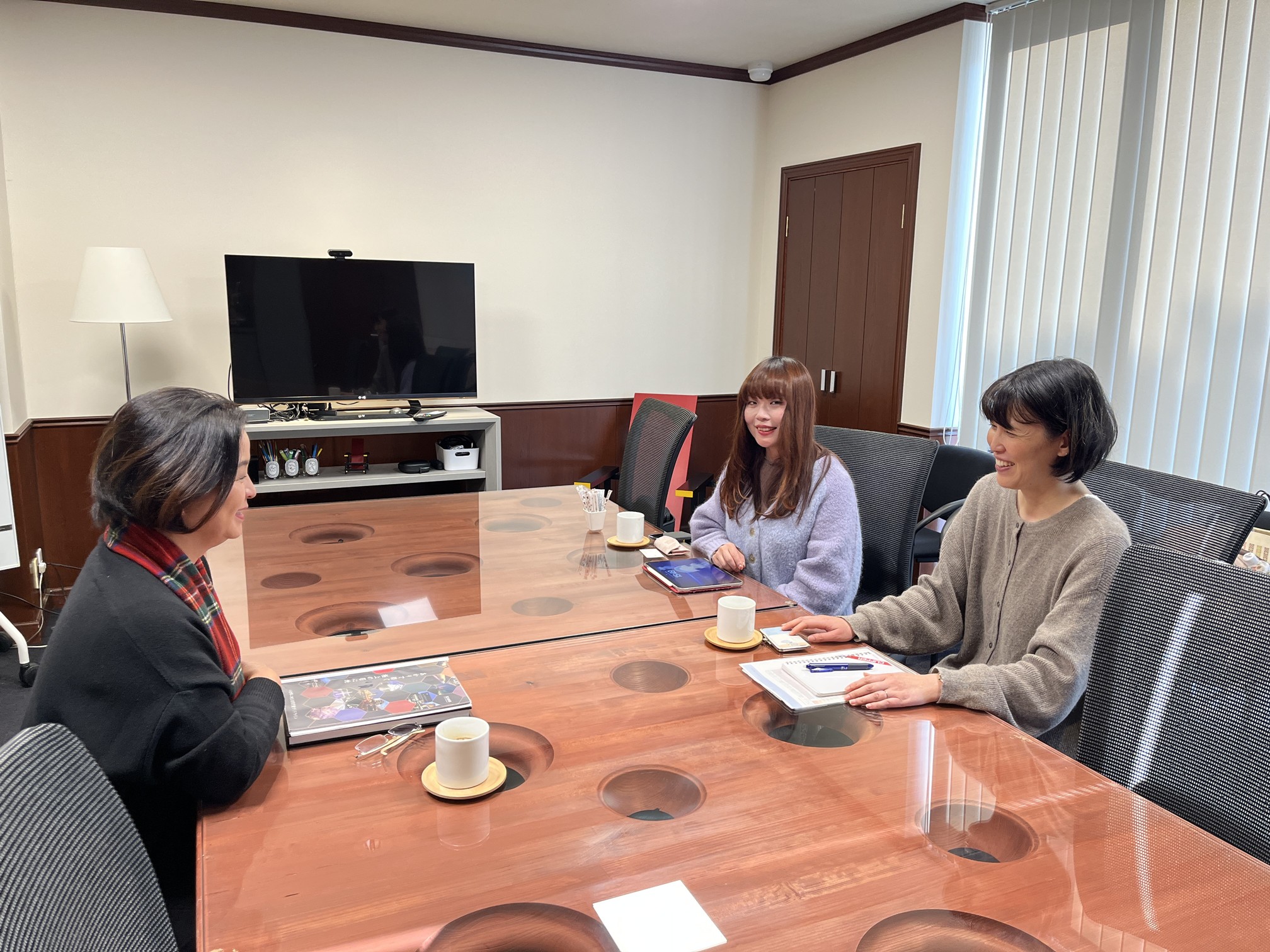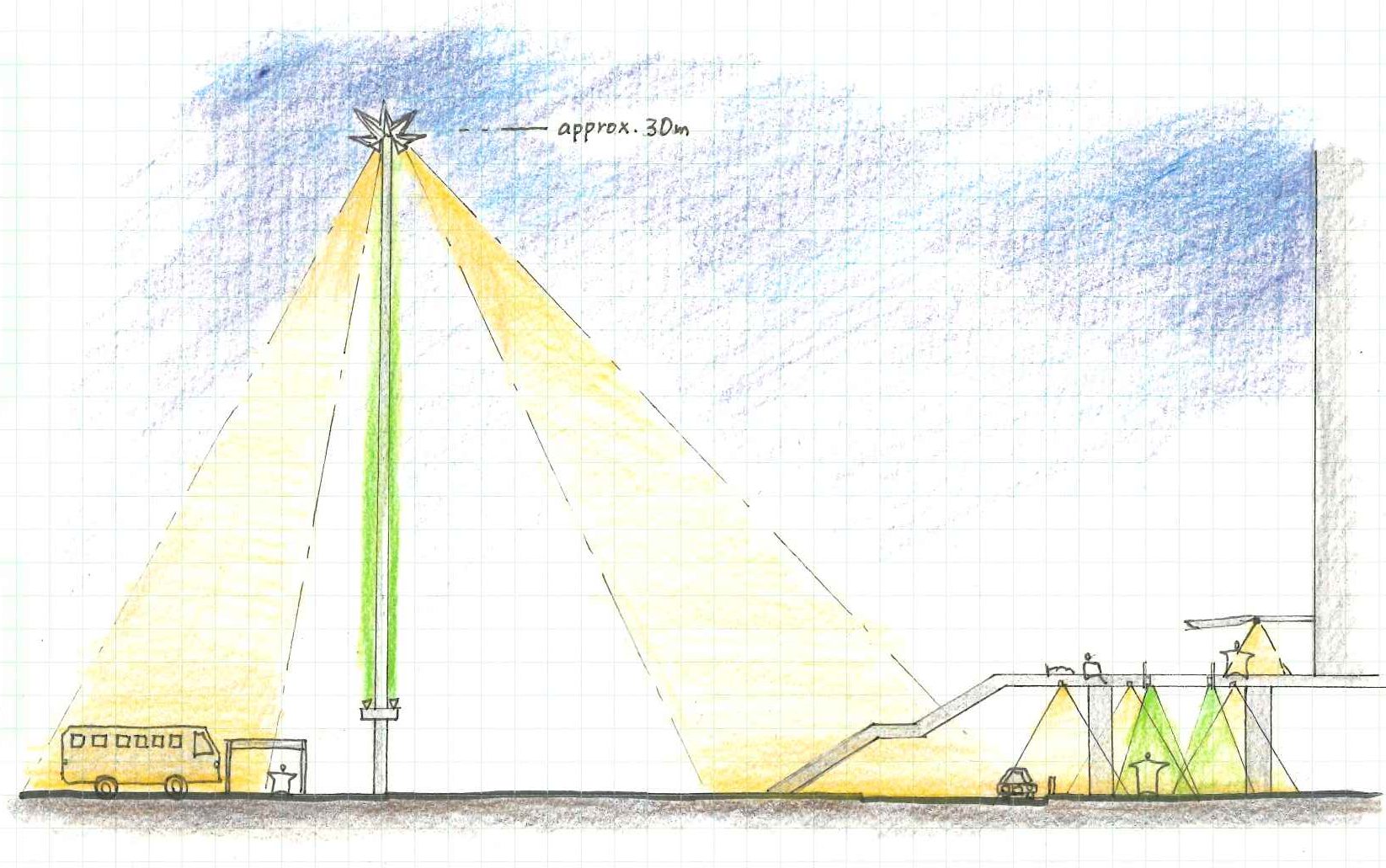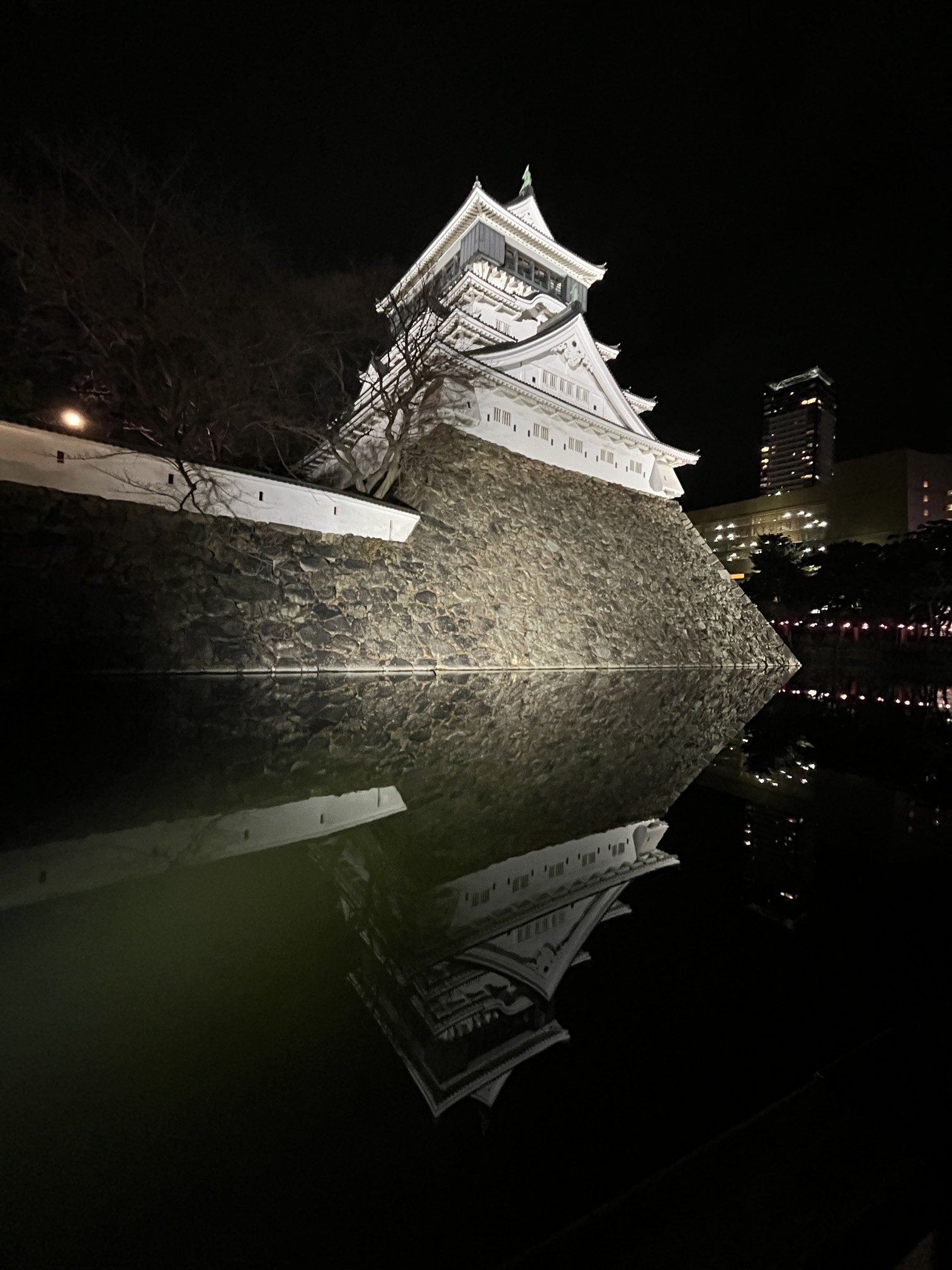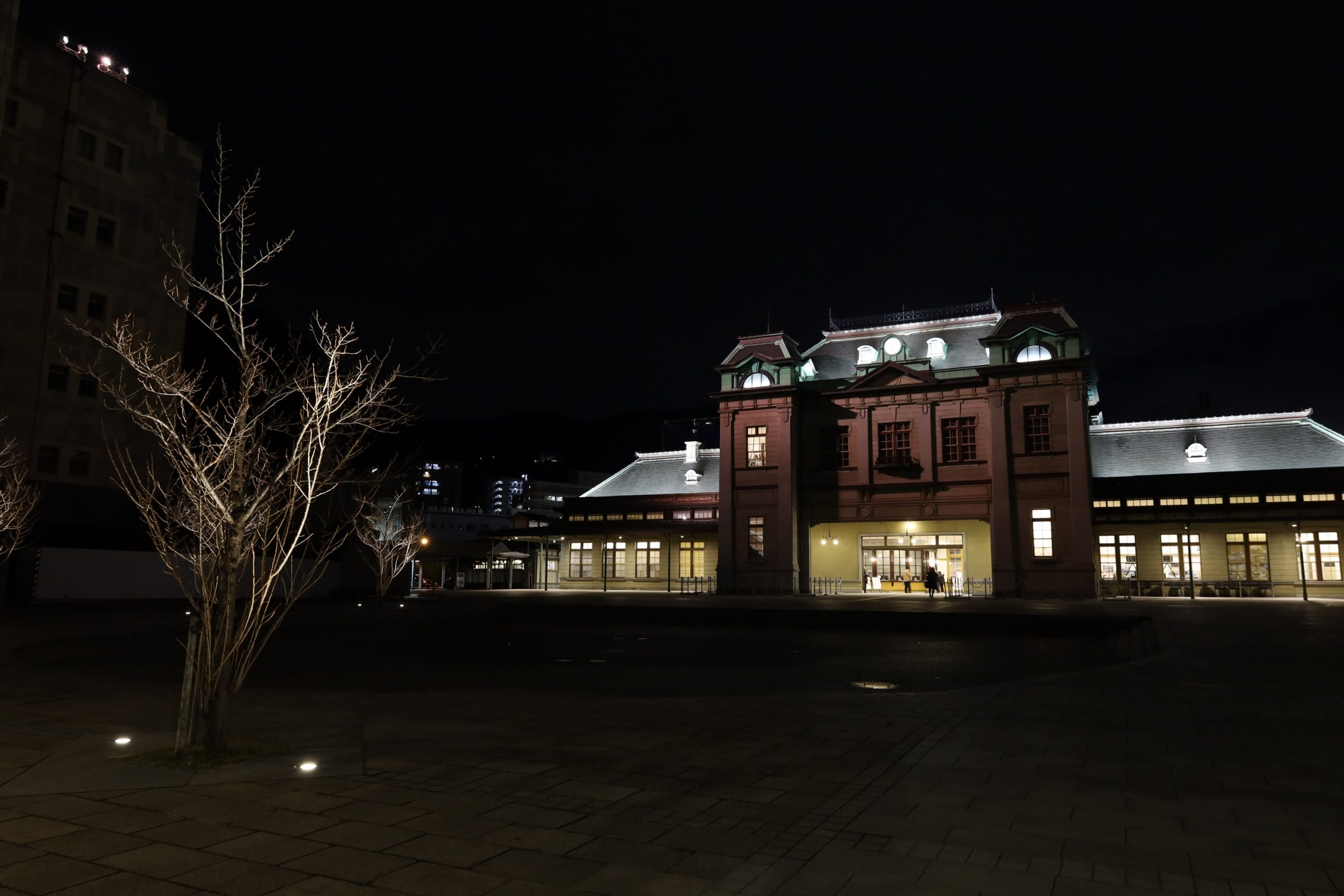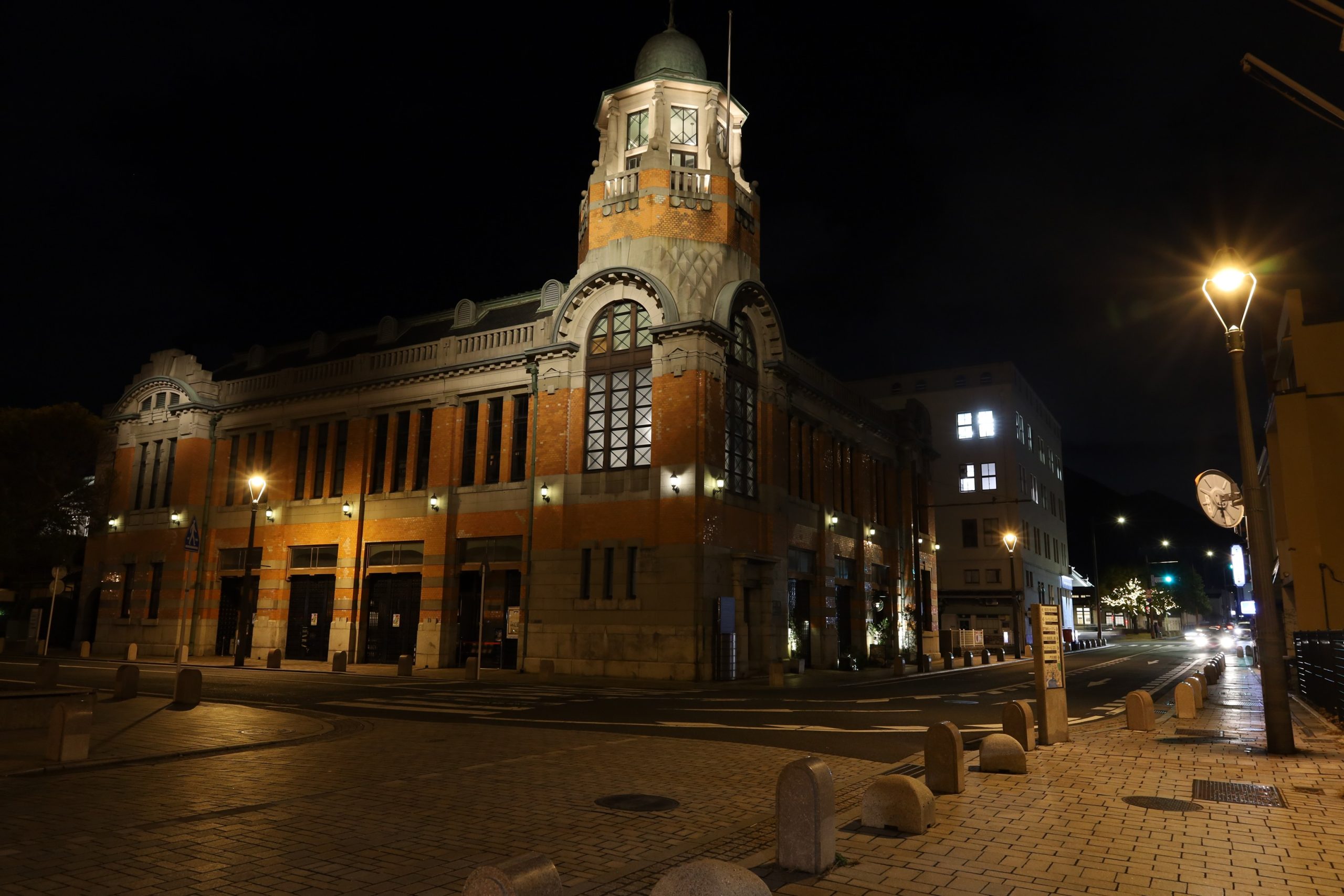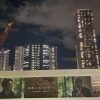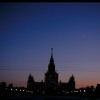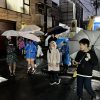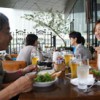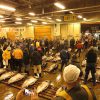2025.01.08-01.11 Misuzu Nakamura + Sachiko Segawa
Kitakyushu City was finally ranked No.1 in the latest “New Three Great Nightscapes of Japan” by the Night View Tourism Convention Bureau. The city has actively utilized its local assets—such as the industrial landscapes developed from the Yahata Steel Works, historic streetscapes, and a terrain of hills and bays—to enhance its nightscape. Surprisingly, this city had not yet been surveyed by the Lighting Detectives, so we set out to rediscover its unique allure.

■Learning What Makes a Compelling Nightscape
Before beginning our survey, we visited Ms. Miki Matsushita, a lighting designer who has long been involved in Kitakyushu city’s nightscape—from formulating the nightscape guidelines for the Kokura city center to planning lighting for various facilities both in and outside the city. We visited her lighting design office in Fukuoka City, which felt as comfortable and refined as an art museum. There, we had the opportunity to hear a wide range of storie—from the time she spent developing the guidelines to her mindset as a lighting designer.
One thing that left a lasting impression was her comment that guidelines shouldn’t become manuals, but rather serve as guidebooks. It became clear that her approach, rooted in deep empathy for the local community, allowed her to foster unique charm through the application of the guidelines in ways that reflect the distinct character of each area. (Misuzu Nakamura)
■Kokura Station Area: The Gateway to Kitakyushu and a Hub of Activity
Our survey began in the area around Kokura Station. Immediately after exiting the ticket gates, we were greeted by a large poster boldly promoting Kitakyushu as “A City of Beautiful Nightscapes,” leaving a strong impression on visitors and raising our expectations for the investigation to come.
While more foot traffic could be found on the Kokura Castle side facing the downtown area, the Shinkansen side of the station also featured an eye-catching lighting plan accented with greenery.
A landmark 30-meter lighting tower stood prominently at the Shinkansen exit, illuminating the station rotary. The overall lighting was not overly bright, but instead struck a balance that conveyed a sense of safety. The pedestrian deck leading to hotels and the exhibition hall featured windows shaped like Shinkansen train cars, softly lit by indirect lighting—an imaginative and playful touch. On the deck, areas with benches were lit only by bench lighting, creating a calm and restful atmosphere. In contrast, busier areas with roofs were well-lit with base lighting, resulting in a space with clear distinctions and thoughtful layering.
After moving to the Kokura Castle Exit and heading south along Heiwa Street, we arrived at a bustling downtown area. A monorail runs down the center of Heiwa Street, with an elevated track structure continuing along the way. The viaduct was lit with soft-colored uplighting, and the road lighting combined powerful fixtures mounted directly under the elevated track with standard pole lights. This resulted in an evenly illuminated space.
Upon reaching Heiwa-dori Station on the monorail line, we found the station building bathed in a
purplish-pink light. However, the actual impression differed from photos we had reviewed beforehand. Upon closer inspection, we noticed a significant layer of dust had accumulated on the lighting fixtures. This likely caused a reduction in brightness and altered the overall appearance.
This experience reaffirmed the importance of regular maintenance and accessibility, especially
when using upward-facing fixtures in areas with heavy traffic.


■A Vibrant Blend of History and Energy in Diverse Shopping Streets
Kitakyushu is home to numerous shopping arcades. Among them, Uomachi Gintengai Street, located west of Heiwa-dori Station, is known as Japan’s first covered shopping arcade. Its arched and high-ceilinged arcade allows ample natural light during the day, and at night, linear lighting and downlights ensure the area remains well-lit. The space felt open and bustling, without any sense of confinement.
A short distance away lies Tanga Market, which has been operating since the Taisho era. Although a major fire struck the area in 2022, many stores continue to operate at a nearby openair market. Tanga Market also has an arcade, but compared to Uomachi Gintengai Street, the ceiling is lower. While the floor illuminance was sufficiently maintained at around 200 lux, the lack of open stores at night made the space feel darker. In contrast, Uomachi Gintengai Street felt more vibrant due to a combination of signage lighting, illumination from open shops, and a brightly colored ceiling that all contributed to a lively atmosphere.
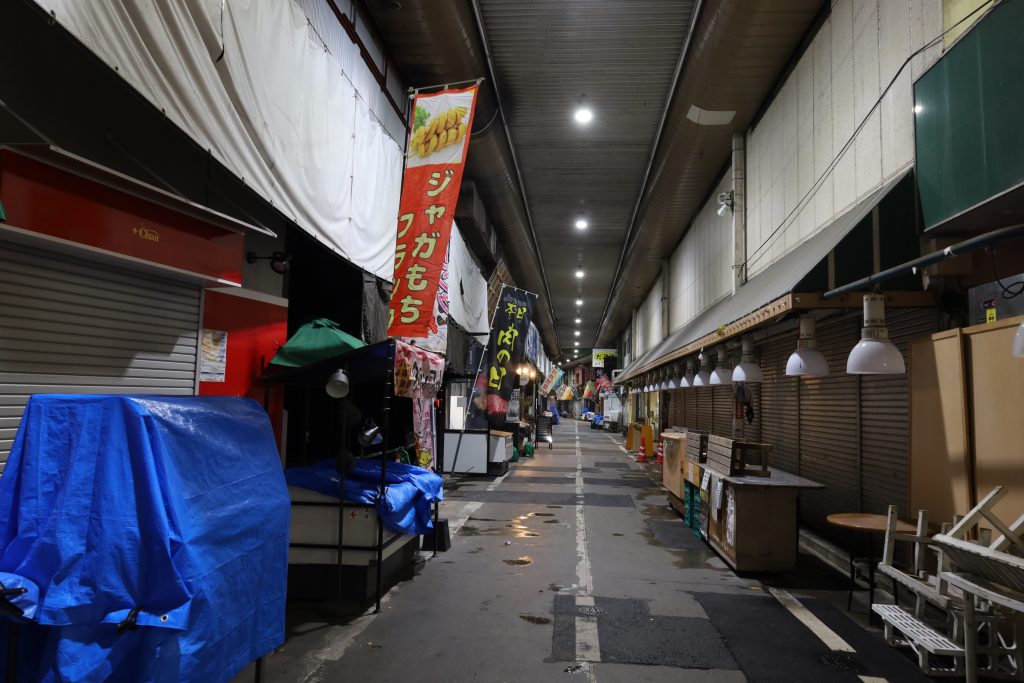
The ceiling is also dim, making the entire space feel dark overall.
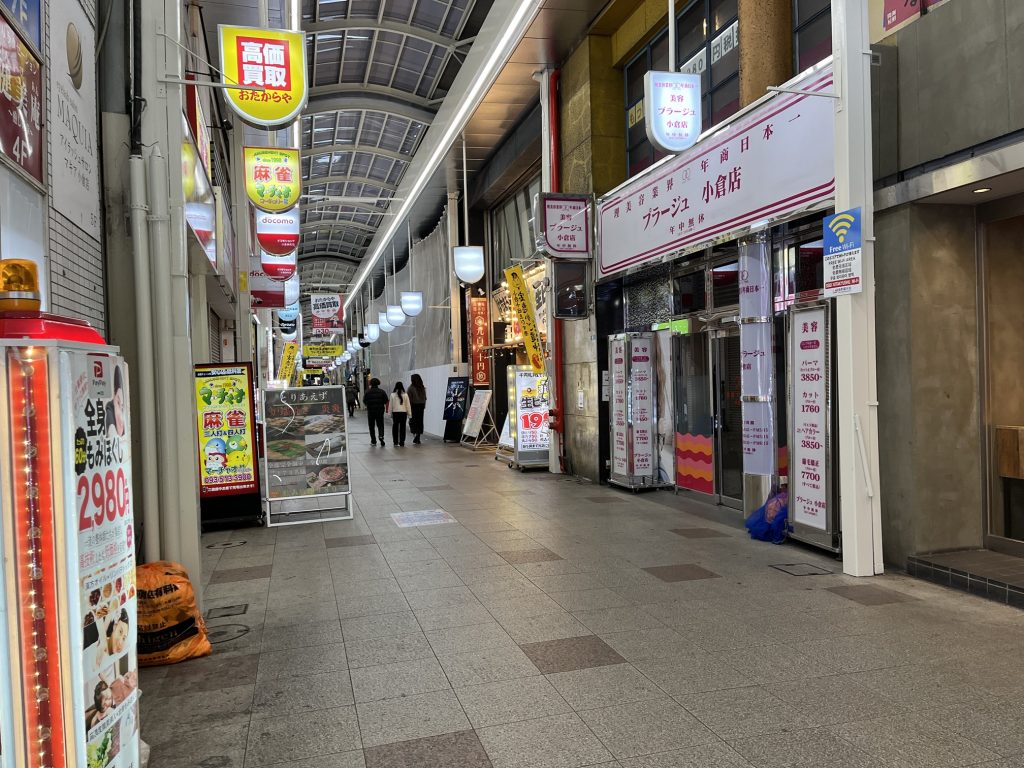
■Kokura Castle and Its Surroundings Steeped in History and Elegance
After passing through the shopping arcade, we crossed the Murasaki River. Despite its short length, the river is spanned by as many as ten bridges, and a phased plan to install new lighting on several of them is currently underway. The river serves as a true “nexus of the city,” connecting Kitakyushu’s cultural district with its bustling downtown area. At the time of our visit, remnants of Christmas illuminations were still visible, and there didn’t seem to be a cohesive lighting scheme across the bridges. However, it is hoped that future lighting will highlight the unique character of each bridge, contributing to a more attractive and unified riverfront space.
On the other side of the river stood Kokura Castle, beautifully illuminated. The surrounding lighting followed the theme of “light that evokes historical ambiance,” gently highlighting features such as white plaster walls and traditional namako-style walls. As a landmark, Kokura Castle is brightly lit in pure white, envisioned as “a castle reflected on the water that remains even with eyes closed.” From a distance, the intense light caused some glare, but seeing the castle’s reflection in the moat clarified the purpose of such brightness. The lighting was provided by floodlights mounted across the moat and on adjacent city buildings. The pathway in front of the castle was lit to a minimal level of 3 lux, but the vertical surfaces of the castle and opposite white walls were sufficiently illuminated, ensuring no sense of darkness or insecurity. (Sachiko Segawa)
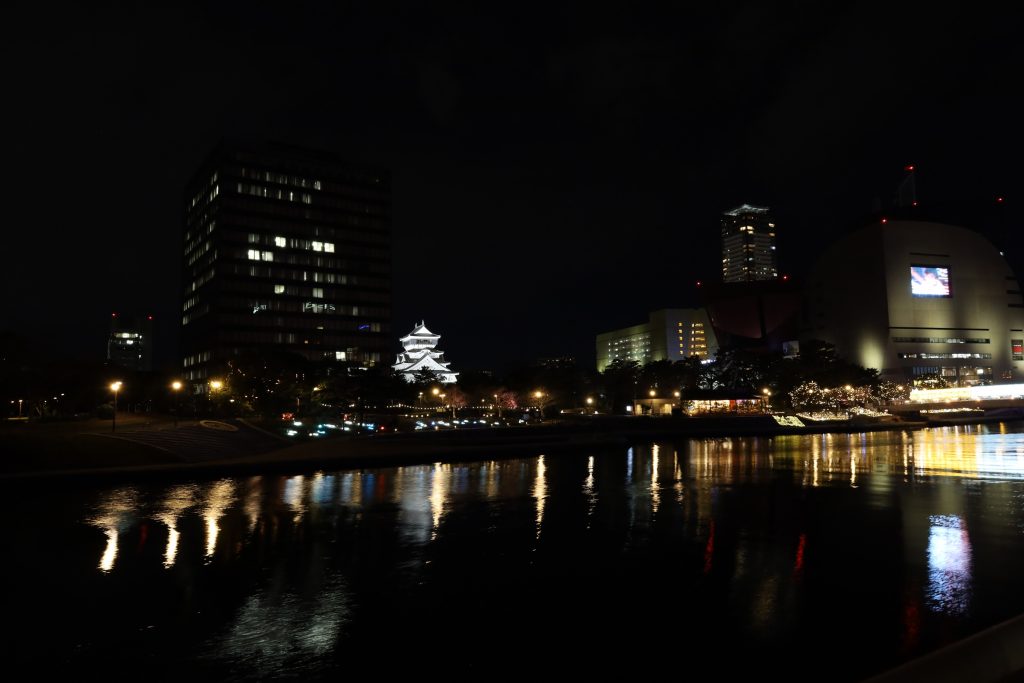
from across the Murasaki-Gawa River
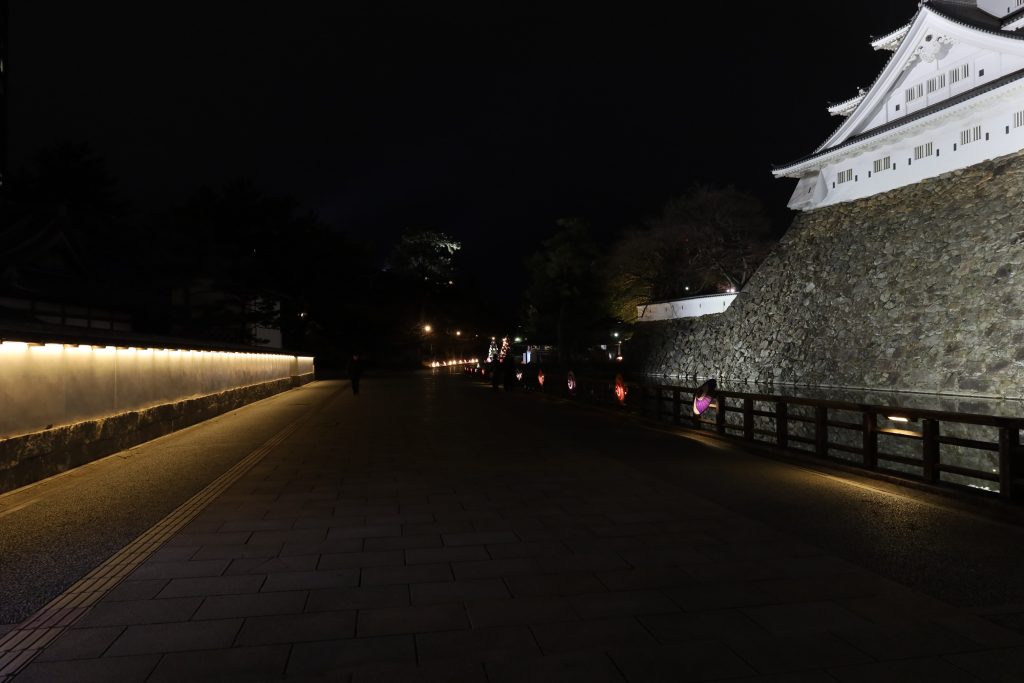
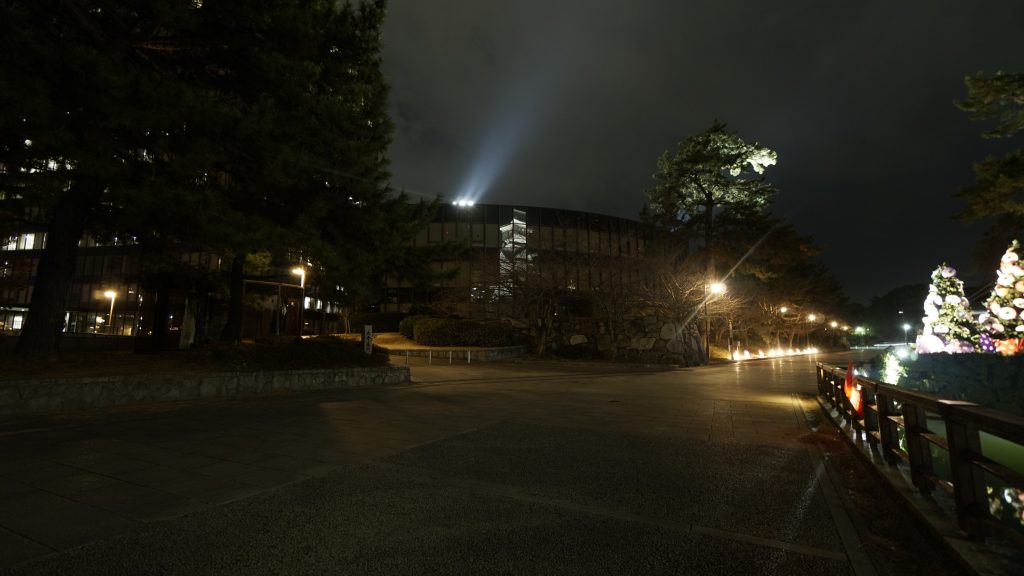
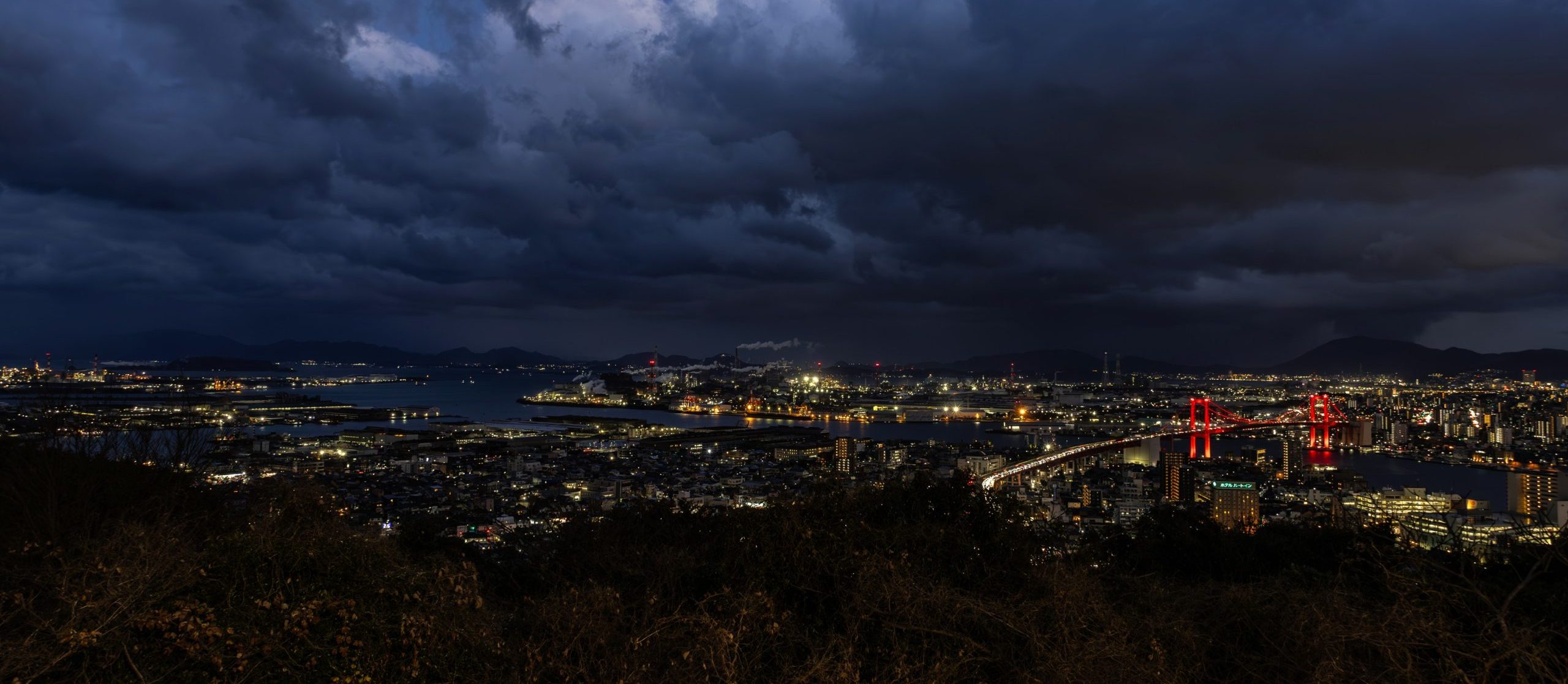
■Breathtaking Nightscape Spot: Takatozan Mountain Park
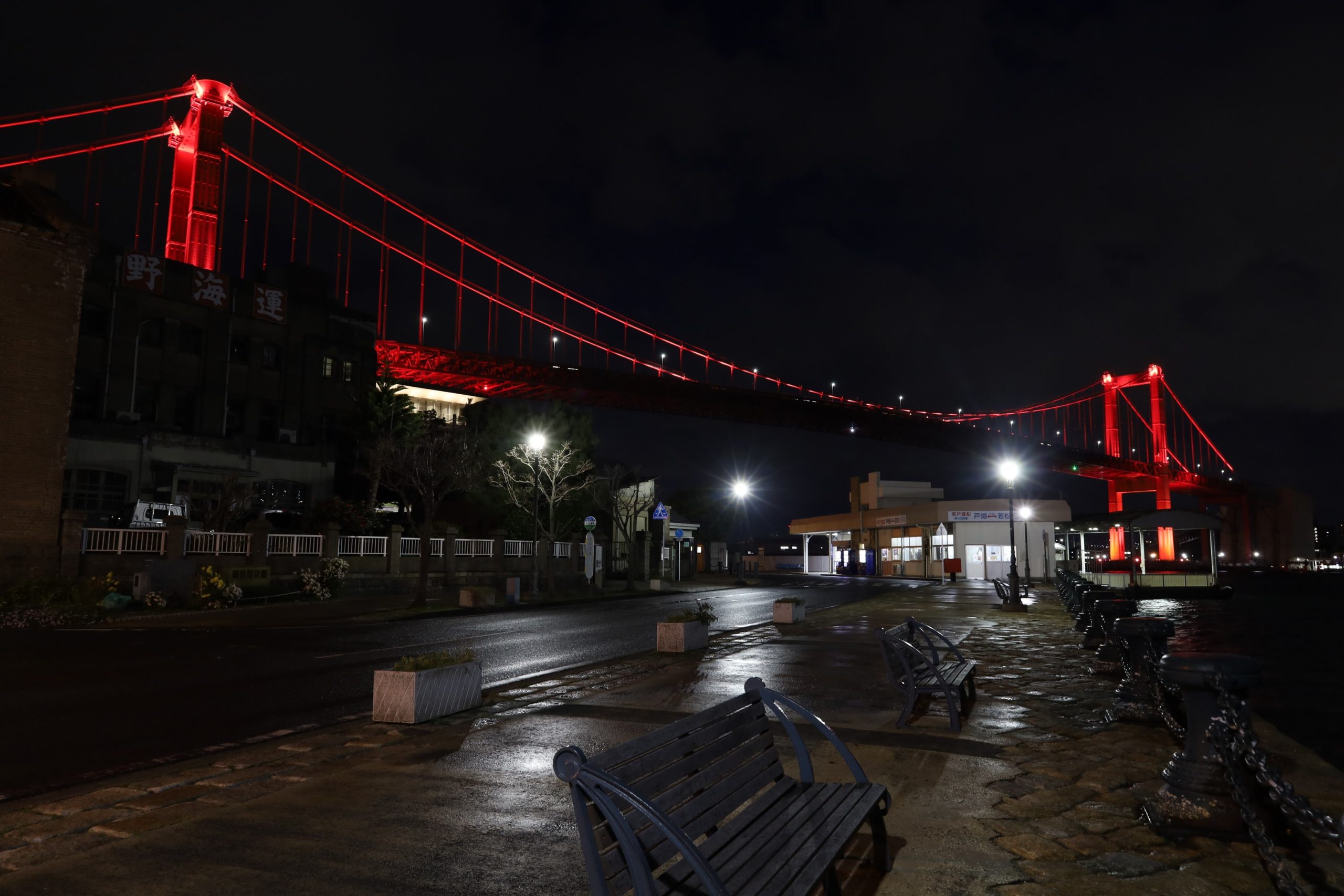
Although the weather was unfortunate with a light layer of snow covering the ground, the observation deck still offered a panoramic view stretching from Mount Sarakura to the Hibikinada Sea. The most striking feature in the scenery was the Wakato Bridge, illuminated in a vivid red. It is said that the two main towers are designed to resemble burning torches, and indeed, they conveyed a sense of strength and elegance that emphasized the suspension bridge’s structure. The red hue appeared deeper and more vivid than during the daytime due to the lighting color, leaving a lasting impression of an elegant and dramatic crimson scene unique to the night.
Beyond the city lights of the Tobata and Kokura areas, which we had crossed by boat, rows of smokestacks could be seen. Streetlights along the bay were scattered across the tangled waters between the factories. The deep red Wakato Bridge tied together this somewhat surreal scene where residential lighting and industrial nightscapes coexist side by side. It was a night view full of presence, offering a vivid experience of Kitakyushu’s unique charm, where diverse urban landscapes exist in close proximity.
■Drawn by the Warm Lights of Ogai Street
After returning to central Kokura, we headed toward the eastern side of Heiwa Street. The warm liveliness of Ogai Street welcomed our cold bodies after being chilled at the snow-dusted observation deck. As soon as we entered the street, we noticed that streetlights of a unified design stretched all the way down the road. At a cozy height of around three meters, the lantern-shaped heads emitted a gentle glow, casting light even onto nearby buildings. Together with functional footlights at ground level, the warm-colored lights formed a continuous path that guided people deeper into the street.
Even the shop sign lights and the lights under the eaves, though individually varied, seemed harmoniously integrated into the lively atmosphere, thanks to the continuity of the street lighting. However, in areas where old white security lights — likely installed before the streetlights were upgraded — still shone overhead, the warm ambiance was noticeably disrupted. This highlighted the challenges of phased public lighting improvements.
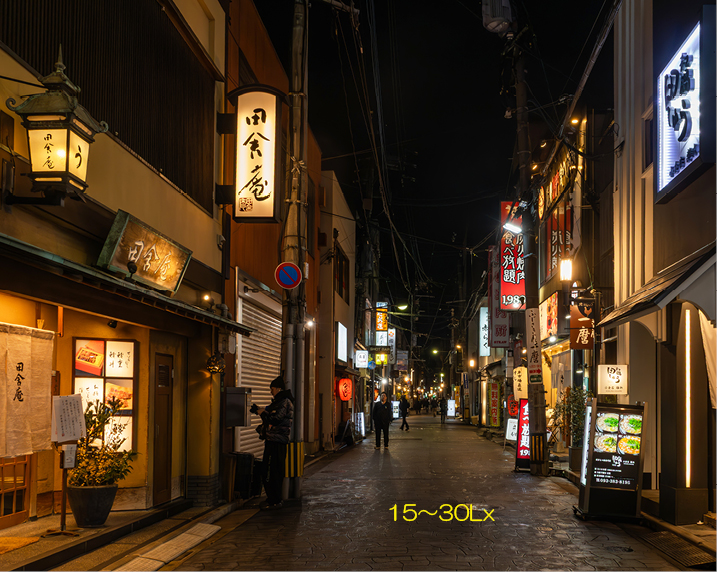
by shopfront lights and street lamps.
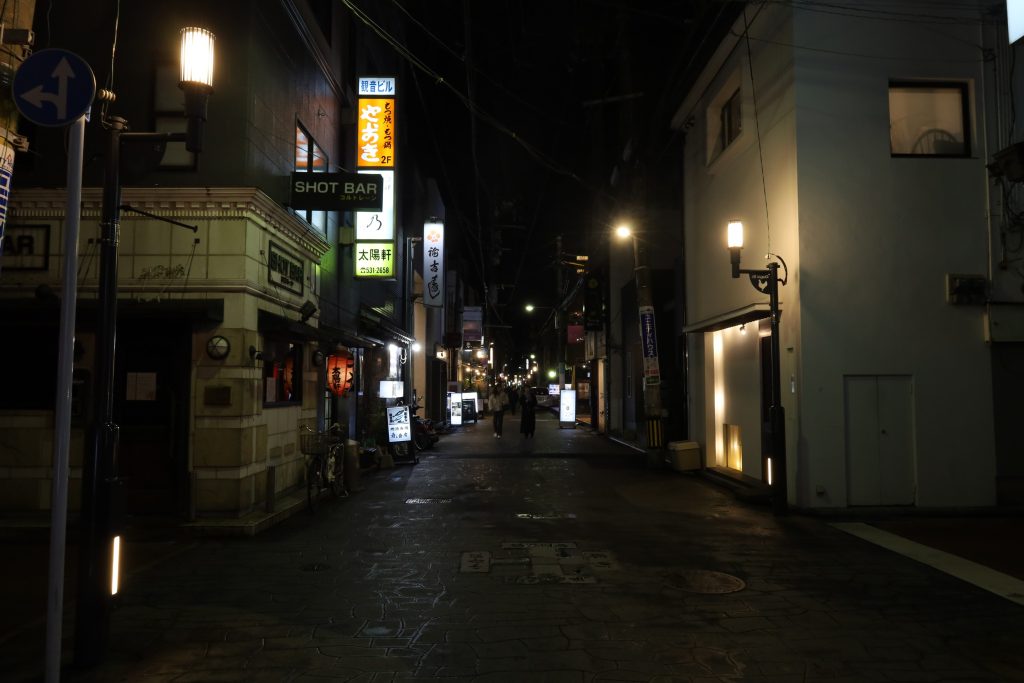
through their lantern-style tops and footlights
■Sakaimachi Park: A Node Connecting the Cityscape
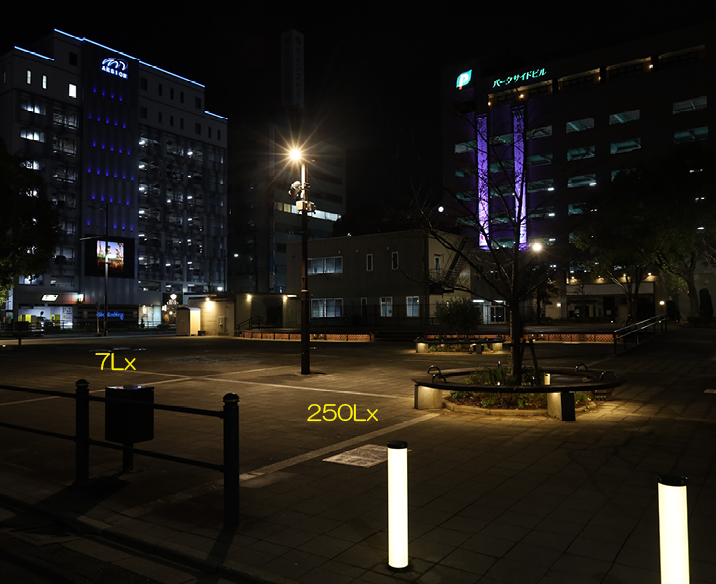
At the end of a narrow alley continuing from Ogai Street, we arrived at the plaza of Sakaimachi Park, which faces a major urban road. From low-positioned lighting such as ground projections and under-bench lights, to illuminated bollards, tree uplighting, and the lit-up surrounding buildings used as borrowed scenery, a layered sense of brightness was achieved, giving the space an expansive feel. It served as a junction connecting areas of the cityscape with varying scales. In contrast to the high color temperature, white streetlights of the adjacent Komonji Street, the park was uniformly lit with warm, incandescent-colored light, creating a comfortable and inviting atmosphere.
■Well-Designed and Carefully Maintained Street Lighting
On wide multi-lane roads, there was a clear consideration in differentiating the types of streetlights used to separate pedestrian areas from the roadway. In some areas, we observed public streetlights equipped with additional lighting fixtures that illuminated the façades of nearby buildings, revealing an intention to design streetlights not only to light the roads but also to enhance the surrounding spatial environment as a whole.
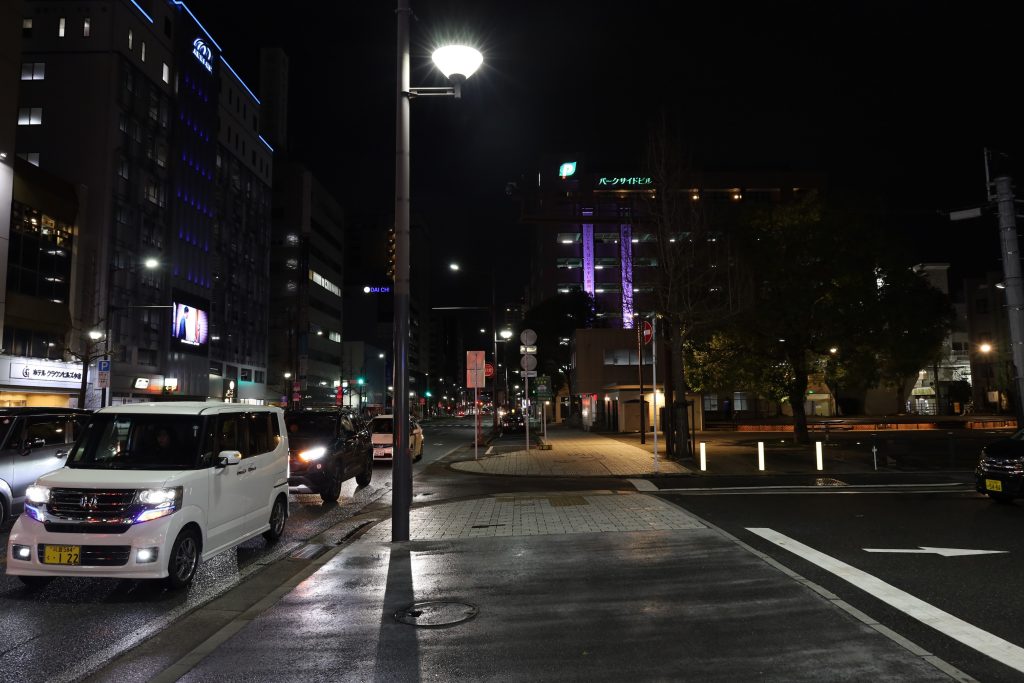
between the roadway and sidewalk.
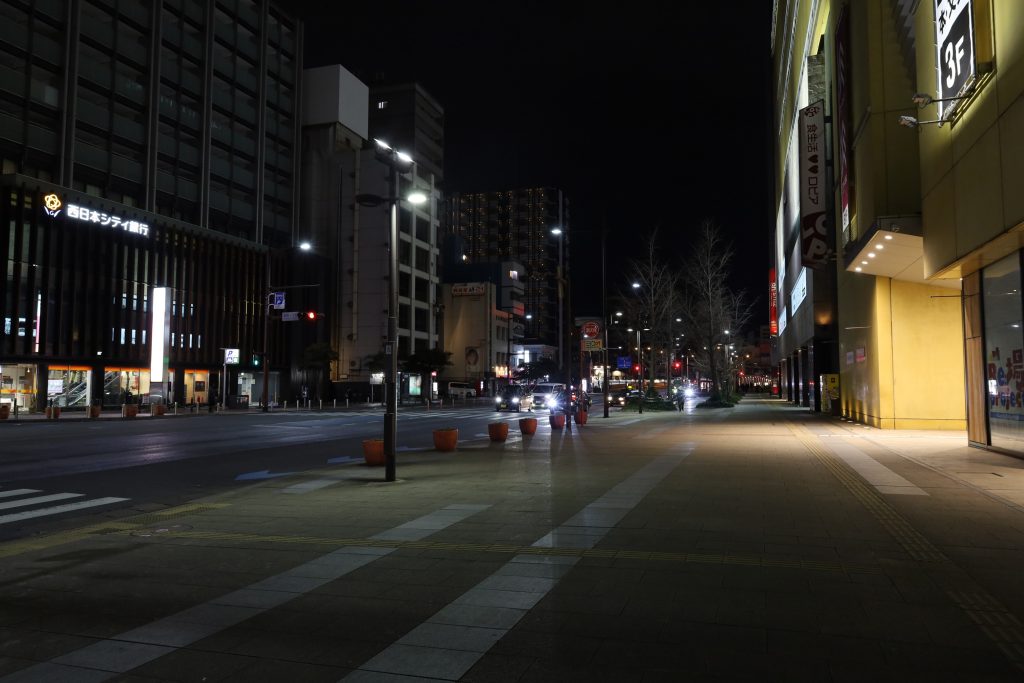
intersections feature building facade uplights.
■Romantic Mojiko Retro
On the final day of the survey, we extended our trip slightly from Kokura to the Mojiko Retro District. Upon arrival, we were greeted by the charming retro-style train station, heightening our anticipation. The compact area is lined with historic buildings, with the sea visible nearby. Just a short stroll through the town evokes a strong sense of nostalgia and atmosphere.
At night, a unified lighting design is applied to each building, using warm-toned lights such as incandescent-style lighting and sodium lamps that enhance the brick façades. This created a warm and romantic nightscape that built on the daytime charm of the area.
From the observation deck on the 31st floor, we were able to take in a panoramic view of the Mojiko Retro District stretching to the Kanmon Strait. The townscape below was free from intense upward glare, and the streets were gently illuminated with warm light. The glow along the waterfront reflected off the surface of the water, creating a postcard-perfect night view.
In some areas, certain spots appeared significantly brighter than their surroundings due to signage lighting installed on the upper parts of buildings reaching down to the ground. When we measured the illuminance levels along the streets, we found most areas averaged between 1 to 10 lux, with a maximum of under 20 lux. However, one spot registered approximately 120 lux, which felt overly bright for the ambiance of the area.
Across the Kanmon Strait, the Shimonoseki side, with the sea in the foreground, appeared dimmer due to the distance. Nevertheless, the string of twinkling waterfront lights offered a glimpse into the life on the opposite shore and created a nightscape full of promise and allure. (Misuzu Nakamura)
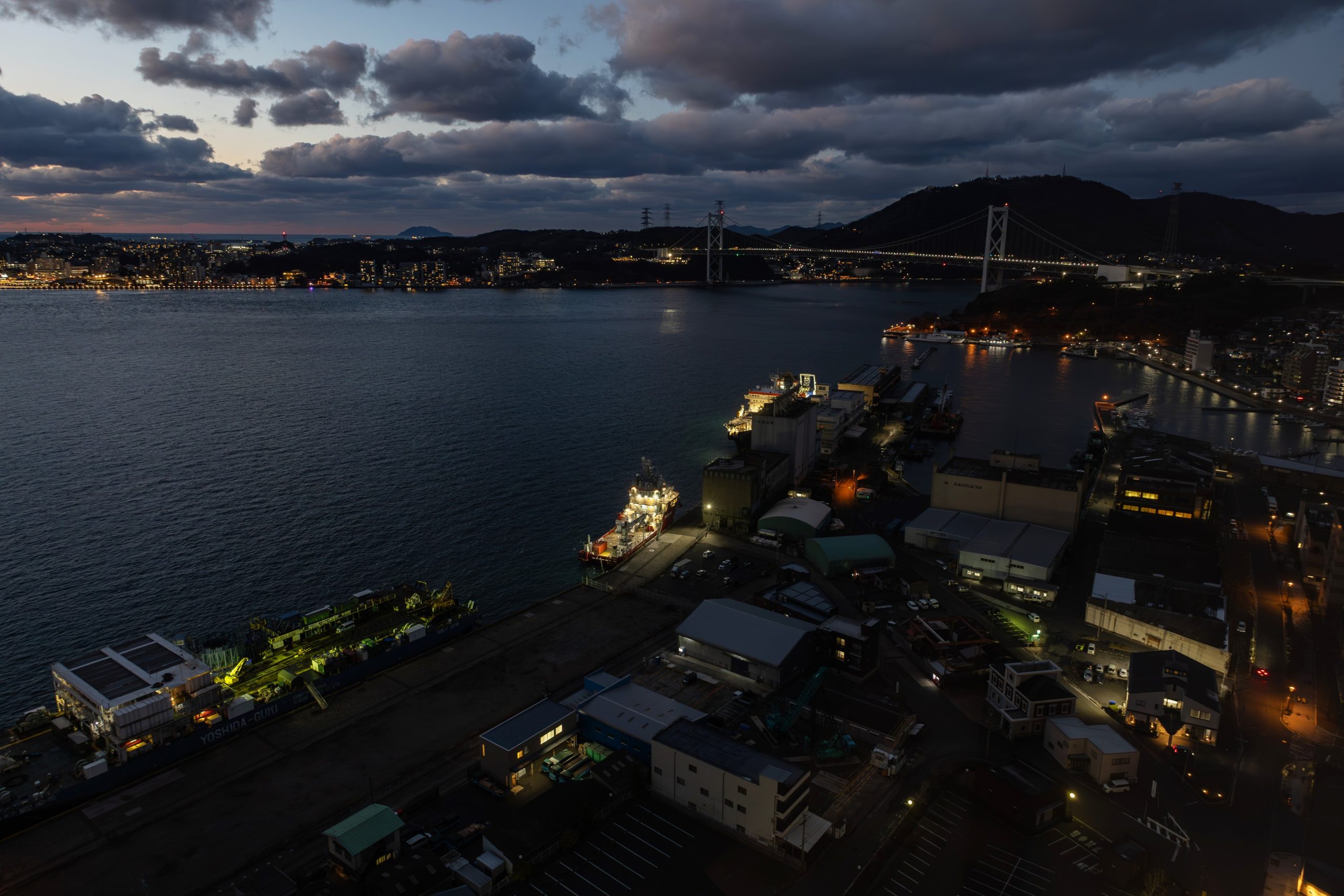
■Conclusion
Located at the boundary between Honshu and Kyushu, Kitakyushu is a unique city where administrative functions, bustling commercial areas, and cultural sites such as Kokura Castle are compactly integrated.
The nighttime landscape guidelines, jointly developed by the public and private sectors, led to the improvement of approximately 80% of the targeted areas within just three years of their formulation. This demonstrates Kitakyushu City’s strong commitment and proactive efforts to enhance urban development through effective use of its nighttime scenery.
Looking ahead, plans are underway to illuminate the ten bridges spanning the Murasaki River. The nightscape of Kitakyushu is set to evolve even further. We eagerly look forward to returning in a few years to experience the transformation firsthand.






